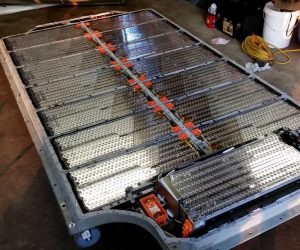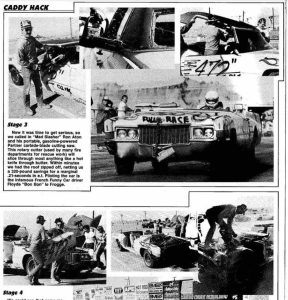A long time ago, Hot Rod magazine – paper and all – published an article called Caddy Hack. It was not about anything online.
It was about taking panels off.
To see how quickly an otherwise completely stock – the term means as it left the factory, un-modified – 1970 Cadillac Coupe de Ville could run the quarter mile when shorn of the weight that made it heavy and thus, slow. In stock trim, the Caddy ran the quarter mile in just under 18 seconds, despite having a high (10.0:1) compression ratio 472 cubic inch V8 – that’s nearly eight liters of engine – under its hood that made an advertised 375 horsepower.
A new Prius – with less than half that power – is quicker.
But the Caddy was crippled by its 4,648 pound curb weight. A container ship has more horsepower than speedboat.
Which gets from A to B sooner?
But what if you could cut the Caddy’s weight by, say, 2,000 or so pounds? And that’s just what the guys at Hot Rod did, literally. With a saw. They used it to hack off whatever the Caddy didn’t need to go quickly, which meant, ultimately, almost everything except the frame and drivetrain. Some 2,000 pounds lighter, the mechanically stock Caddy was as quick as most muscle cars of the period, running a best time through the quarter mile of 13.5 seconds at more than 100 MPH. 
How quick – how efficient – might today’s cars be if they weren’t required to be as heavy as they are?
The ’70 de Ville was heavy because it was meant to be. People bought Caddys because they wanted a big, heavy car. The government, at any rate, wasn’t adding weight to cars – via regulations that had to be complied with – back in 1970. Cadillac was free to build cars like the 4,648 lb. de Ville and Datsun (Nissan, today) was just as free to build cars like the 2,127 lb. 1600 (which got by with a – you guessed it – 1.6 liter four cylinder engine).
Today, there are no new cars built like a ’70 Cadillac, such cars having been regulated out of existence. Full-perimeter steel frames gave way to welded-together unibodies (much harder to hack) and V8s – the few that remain – are much smaller and made of aluminum, mostly, rather than cast iron.
And yet, even small modern cars weigh on average 800-1,000 lbs. more than a 1970 Datsun 1600. A new Prius, for instance. Its curb weight is an astonishing 3,220 lbs. A small electric car such as the Tesla Model 3 weighs almost as much as a ’70 de Ville – more than 4,000 lbs. for the “long range” model.
It would be illuminating to hack the Tesla and see how much farther it could go. Or – rather- how much less battery it would need to go as far.
The main reason the Tesla – and electric cars, generally – are so horribly inefficient is because they’re so preposterously heavy. The Tesla 3, for instance, is a car about the same size as a Honda Civic, both being about 184 inches long – which makes them both compact-sized cars. But the Honda weighs about 1,100 pounds less – because it is not carrying around 1,000-plus pounds of batteries.
The Tesla has to carry them around, in order to be able to tout the quickness (rather than efficiency) that sells the car. But it could be both – quick and efficient – if it weren’t required to carry around 800-1,000 pounds of government-mandated deadweight. Everything necessary to successfully get past the gantlet of crash-test/bumper-impact/rollover and similar “standards” that make even a compact-sized car weigh almost as much as super-sized cars weighed in the days before the government got into the business of telling car companies how “safe” the cars they built had to be.
This defined as being in compliance with whatever the currently applicable crash-test/bumper-impact/rollover “standards” happen to be – plus air bags, back-up cameras and so on. Note that none of those things bear on whether a given car is more likely to crash; only that if it does, it will provide more crash-protection.
The distinction isn’t trivial. Not if you care as much about efficiency every time you drive as opposed to what might happen, if you crash.
The miracle is that a car like the Tesla goes as far as it does – given how much it weighs – because of how much it has to cart around, in order to counterbalance how much it weighs. And that it is as “efficient” as it is, given how much it weighs.
Same for cars like the Civic – which is only just barely as “efficient” as the same-size (but much less weight) cars of 40 years ago, when cars that size weighed closer to 2,000 than 3,000 lbs.
If it weren’t for all that government-required weight, a car like the Tesla wouldn’t need 1,000-plus pounds of batteries to be as quick as it is. And it would be a lot more efficient than it currently is – both in terms of how far it could travel and also how much energy it would need to travel.
A car like the Civic, sans 800 or so pounds of government-required deadweight – would be getting 50 MPG on the highway rather than 40.
And both it and the Tesla would cost thousands less than they do.
That’s a hack we’d all benefit from – and it wouldn’t require hacking off the doors and hood and roof, either.
. . .
Got a question about cars, bikes or anything else? Click on the “ask Eric” link and send ’em in! Or email me at EPeters952@yahoo.com if the @!** “ask Eric” button doesn’t work!
If you like what you’ve found here please consider supporting EPautos.
We depend on you to keep the wheels turning!
Our donate button is here.
If you prefer not to use PayPal, our mailing address is:
EPautos
721 Hummingbird Lane SE
Copper Hill, VA 24079
PS: Get an EPautos magnet or sticker or coaster in return for a $20 or more one-time donation or a $10 or more monthly recurring donation. (Please be sure to tell us you want a magnet or sticker or coaster – and also, provide an address, so we know where to mail the thing!)
My eBook about car buying (new and used) is also available for your favorite price – free! Click here. If that fails, email me at EPeters952@yahoo.com and I will send you a copy directly!












I drove a ’68 Sedan de Ville with a 472 in the ’70’s. That car would smoke the tires as long as you pressed the pedal to the floor, until about 50 mph as I recall. Smooth ride, fast enough, quiet and sound riding down the road. In a couple bumps with other vehicles and not a dent on the Caddy. Whatever happened to the 5 mph bumpers? I look at some of the cars now and think, if that hit a pole there would be 5 grand of damage, if not totaled if it deployed the airbags.
Hi AMNTRAT,
I enjoyed driving those wonderful American lead sleds, too! About the bumpers: They are underneath the plastic covers. This way they don’t have to chrome plate them – saves money. This way, when you get in a fender-bender, the plastic tears – costing you money!
Interesting note… the Cadillac Hack article in Hot Rod isn’t the only time a magazine staff has cut up a full size car in the quest for quicker quarter mile times. Around 20 years ago Mopar Action magazine took a near mint original 1965 Imperial sedan and eventually cut it up much like the Caddy and got it to run 12s I believe.
413 big block? There’s a local guy with a mint Imperial for sale for 16k. 413 big block I believe. Very tempting.
My thoughts for a long time, being sensitive to government corruption for a long time, is that the insurance lobbyists were more generous than the auto lobbyists. The result was that the regulations became all about improving insurance profits by lowering payouts for auto accidents. So lots of regulations for saaaaafety that have imposed insane restrictions on auto makers. The higher fuel prices were just an excuse to cover-up the real corruption. Note that simultaneously the government scum also introduced reporting laws that made it easy for insurers to raise rates (and profits) on anyone who got a ticket for a ‘moving violation’ even when there was no injured party of any kind.
I know there were a lot of “factory racing specials” made in the early 1960s that were, well, “weight reduced.” The “Swiss Cheese”
Pontiacs come to mind. Their performance was impressive at the time, and even by today’s standards.
Also the 68 Hemi Dart. Low buck, stripped down race car.
I used to know this skinny dude named Ricky. He drove a whipped 78 Camaro. He was always talking about how it had potential. Ricky’s girlfriend was this rotund abrasive war pig named Jennifer ( pronounced JENFER). She steamboated Cambridge cigs and always had sweat on her upper lip. Ricky loved his ol’ red neck Camaro but complained about its gas mileage. I know he would have gotten better economy if he was not lugging around his ton of fun!
Thank you for the laugh!
‘even small modern cars weigh on average 800-1,000 lbs more than a 1970 Datsun 1600’ — eric
In 1975, the EPA started collecting statistics on vehicle weight. The image below, a screenshot from a 2020 EPA report, shows average weights for several kinds of vehicles:
https://ibb.co/W6brF5Y
The ‘all vehicles’ chart (black line) is affected by a change in vehicle mix after the first oil shock in 1973: more compacts sold; fewer full-size vehicles.
What stands out is that the tubbiest of the fatties are — you guessed it — pickups (blue line). Compact pickups that held the average weight down in the mid-1980s aren’t even made anymore.
LBJ’s chicken tax still haunts us more than half a century later, as a petrified Clowngress does what it does best: NOTHING.
Everything is cyclical. The ‘all vehicles’ chart shows that the average fleet weight dropped from 4,100 to 3,200 lbs in 1975-1978, when auto buyers panicked into smaller vehicles as the era of cheap oil ended.
If we are entering a new secular trend of relentless inflation in energy and materials prices, it could all happen again.
What you can count on is that Big Gov will be the last to get the news, probably mandating a costly weight reduction campaign after the worst is already over.
On top of the weight, the nose has been blunted for pedestrian safety, aerodynamics be damned (even though I have never known anyone hit by a car). Although I would much prefer getting my legs cut out from under me than a full impact on my upper thigh/hip. On top of that, thanks to the excessive caging, you can’t see out of them except for straight ahead. I once talked to a Mercedes owner who bragged about how well the car stood up to being rolled. To which I responded that I was not in the habit of rolling my car.
I’m reminded of Lotus founder Colin Chapman’s adage to “Simplify, then add lightness.” He died in 1982 and would mortified to see how porky cars have become thanks to the dictates of the all-powerful, largely unelected gubmint as we say here in NW Florida.
Wonder why Saab died and Volvo is owned by ChiComs? When the gubmint mandated all of the safety equipment on every car, it killed the whole point of paying a premium for those Swedish machines.
I was looking at curb weights for my beloved 1991 Honda Prelude Si and my present daily driver, an Infiniti G37. Even though the G has nearly 200 more horsepower (my ‘Lude had about 140), it is 1,000 pounds more than the old Honda with its snickety-snick 5-speed and 4-wheel steering. That is the only car I ever regretted trading (even though the Firebird Formula I swapped for it was a fast, fun car.)
Lets not forget when Hot Rod Magazine put a 500 cubic inch Cadillac motor into a Chevette. Sure the firewall had to go and you needed a Nomex racing suite to be strip legal but a good time was had by all (excepting an abused Chevette). While I suspect there is still a market for a Datsun 1600, .gov feels they not safe or low enough co2 for them. Of course .gov is only getting started. Next up: motorcycles that weigh 1600 pounds due to being electric………
The guys on Roadkill put a 426 hemi in a Gremlin, called it the Hemi Gremmie.
https://www.youtube.com/watch?v=C2I7SnrpGCo
I am amazed that those old caddy’s were 4600lbs and my ram is 5200lbs. Maybe why I like my ram so much. I am also amazed at how much these newer small cars weigh so much.
We are in crazyville. Thanks Eric.
Ditto, Chris!
Crazy times, indeed…